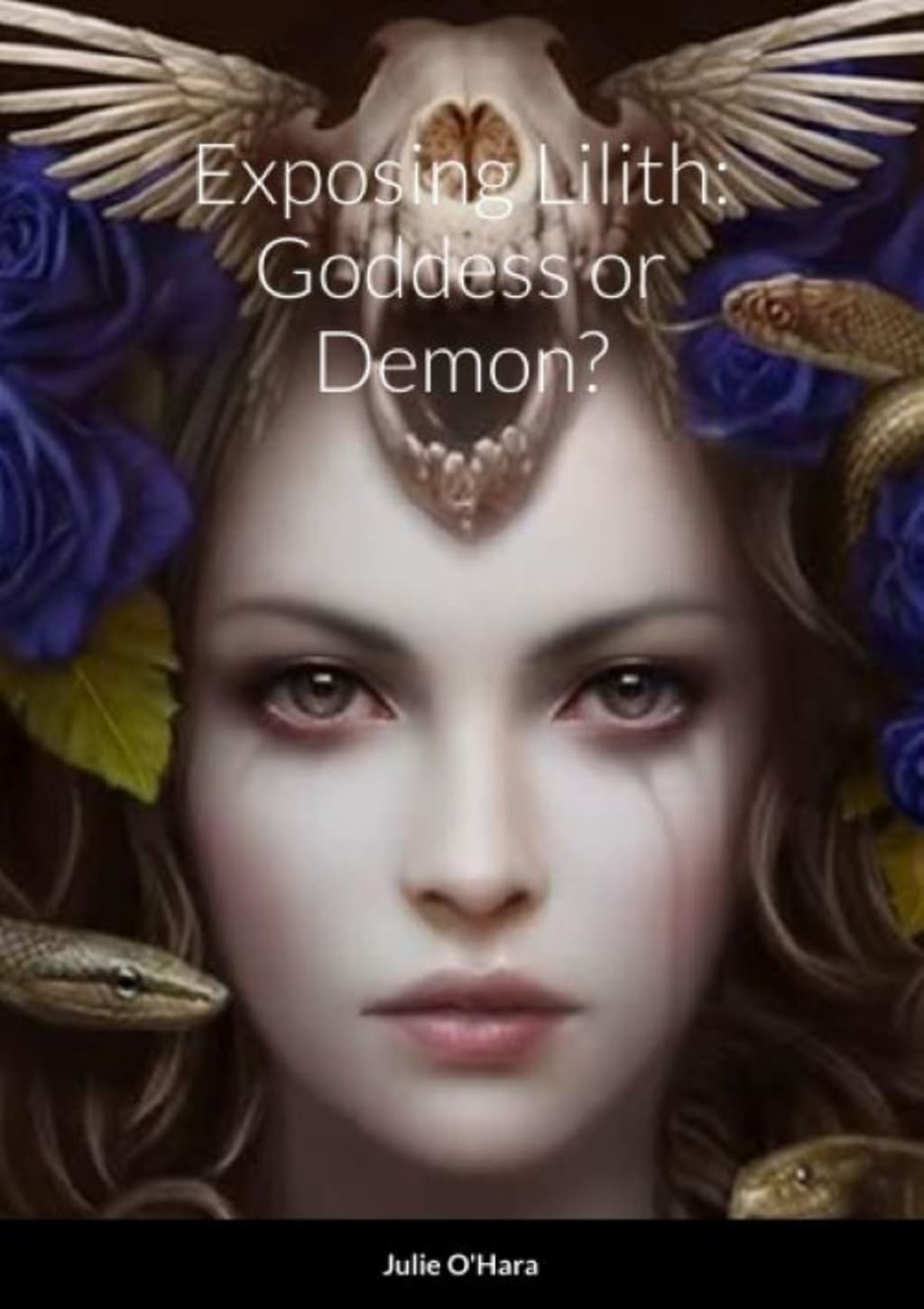Exposing Lilith:
Goddess or Demon

Lilith, rumored to be the first wife of Adam has been misunderstood for millenium. I have spent the last 20 years researching her story and history and have published the book Exposing Lilith: Goddess or Demon.
Unfortunately, in our time, her legend has been misused to promote agendas of hatred and intolerance.
First and foremost, she was not a nice person. She should not be considered a role model (she murdered her children and then ate them. No role model material). She is purported to kill children and men in their sleep.
I have attached the first chapter and the table of contents of the book. You can purchase the book through me at
Paypal: [email protected] for $24.99.
I will have it dropshipped from my publisher and I will pay for shipping.
Enjoy.
Table of Contents
1. Who Is Lilith?
2. Lilith, Adam, and Eve
3. The Myth Defined
4. The Lilith Archetype
5. Defining the Divine Masculine and the Divine Feminine
6. Toxic Masculinity and the Patriarchy
7. Toxic Femininity and the Matriarchy
8. Sacred Sexuality
9. Steps to Practicing Sacred Sexuality
10.. Origins of Succubus and Incubus
11. Glamorization of Evil
12. Different Beliefs About Lilith
13 Lilith in Other Cultures
14. Lilim and the Daughters of Lilith
15. Epithets, Associations and Names of Lilith
16. Lilith in Literature and Popular Culture
Chapter One
Lilith is probably the most famous of all female demons in the Western esoteric tradition, and she is also likely the most misunderstood. She has been portrayed as a spurned human, a disgraced angel, a lascivious lover, the mother of the children of the most monstrous of fallen ones, as well as the perpetrator of filicide (murdering one’s own children) in addition to a vicious killer of other people’s infants. For some, she is misguidedly painted as a goddess and a feminist role model, and ironically, as a symbol of female empowerment.
If you are holding this book in your hands, her name is most likely familiar to you as well.
Throughout history, darkness has long been the place of the deepest fear of man and his most terrifying nemesis because of the strange and dangerous creatures that are known to lurk in its shadows. Lilith, identified as the first succubus, a female demon believed to have sexual intercourse with sleeping mortal men, is one of the most heinous and feared of these creatures.
First encountered in ancient Sumerian lore, she is shown naked in her oldest depictions, with prominent breasts and wild, often red unbound hair, symbolizing her untamed and dangerous sexual energy and power, which is the key to her initiatory gnosis.
In medieval legends, she shapeshifts into the serpent in the Garden of Eden, tempting the first human couple to taste the fruit from the Tree of Knowledge thus becoming the first seducer and the first adversary in the history of mankind.
In some facets of Jewish tradition, she is portrayed as the first wife of Adam who devolved into the mother of all demons and abominations of the earth becoming the impetus for the ultimate manifestation of the Divine Masculine and Divine Feminine.
In European folklore, we meet Lilith as the presiding goddess of the Witches’ Sabbat and the female leader of the Wild Hunt. She is identified with Medusa who kills men with her deadly gaze, the Harpy who shrieks in the night, Lamia who devours her lovers, the Lorelei seducing seafaring men to their demise, and other terrifying blood-thirsty hags and man-eating monsters.
In Jungian psychology, she represents the Anima - the dark, unconscious part of the Self.
Finally, in modern feminist ideology, she is ironically seen as the ultimate liberated woman and the embodiment of female empowerment.
The earliest mention of an entity with a name similar to that of Lilith is found in the Sumerian king list from the third century BCE, stating that the father of the famous hero Gilgamesh was Lilu, a demon; a kind of an incubus.
There were several types of spirits associated with sexual activities in Mesopotamian lore: the male was called Lilu, the female was Lilitu or Lili, and there was also Ardat-Lili and Irdu-Lili. Lilu was believed to wander through deserts and in open areas and was especially dangerous to pregnant women and infants.
Lilitu seemed to be his female counterpart, and Ardat-Lili, whose name means “maiden”, was supposedly a young girl incapable of normal sexual activity, aggressive and dangerous toward young men. Irdu-Lili was her male counterpart. In a sense, Ardat-Lili and Irdu-Lili could be viewed as the highly hormonal adolescent versions of Lilu and Lilitu.
In modern times, these theories have been questioned and debated by many scholars who claim that these spirits were originally storm and wind demons and their association with medieval succubi and incubi is due to wrong translations and misinterpretations.
It is the same with the well-known Burney Relief (also known as the Queen of the Night relief), a Mesopotamian terracotta plaque in high relief of the Isin-Larsa period or Old-Babylonian period, which is commonly identified as Lilith, although current thought has her now identified with Ishtar or Ereshkigal. The relief shows a female entity with wings and owl feet, standing on two reclining lions.
The relief is currently displayed in the British Museum in London, which has dated it between 1800 and 1750 BCE. As noted above, it originates from southern Mesopotamia, but the exact location site is unknown. Apart from its distinctive iconography, the piece is noted for its high relief and relatively large size making it a very rare item that has managed to survive from this ancient period of time. The authenticity of the object has been questioned from its first appearance in the 1930s, but current opinion has generally moved in its favor over the subsequent decades.
Indeed, the name Lilith, which is most likely derived from Hebrew, is not found in the Mesopotamian sources. What we find are only words similar in their roots, but not necessarily referring to the Queen of the Night from the Hebrew lore.
According to Judaical thought, Lilith was thought to be the most beautiful woman ever created and was fashioned based on Adam’s longing for companionship and to be the perfect mate for him. She was designed to be his helpmate, his divine counterpart, his wife, his lover, his best friend, and the mother to his children. According to legend, the Creator created Lilith from the same dirt as Adam and thus she was designed to be his equal.
• She was not designed to be subservient.
• She was not meant to be overpowered.
• She was not meant to be dominated.
• And she was not meant to be controlled.
Yet despite the Creator’s clear intent, modern and popular rhetoric has persistently chosen to embrace her as a victim of the “patriarchy” and “male dominance and toxicity” and that she was banished from the Garden of Eden for standing up to Adam and God, which is simply not true. Lilith got angry and left of her own accord. She was shown mercy and given numerous opportunities to return, but she chose not to. This book is going to argue that modern rhetoric painting Lilith as a victim is false. It is simply an attempt to promote a false socio-political agenda based on corrupted ego.
To truly understand the story of Lilith, we have to understand the definition of the word, “helpmate” as Lilith is referred to in many texts, both ancient and modern.
Look closely at the word. “help” and “mate.” Mate implies equality. If you referred to a close friend of yours as your “mate” you would not be demeaning them, you would be describing them with honor, respect, and closeness. It is a term of equality. Lilith, and subsequently, Eve, were created to be the “mate” of Adam, a “helpmate.” It was never meant to be a derogatory term or role, but a truthful and sacred one. Lilith was designed to be a best friend and life companion for Adam. And Adam was designed to be the same for her.
In the English translations of Genesis 2:18, the word is the noun ezer, עֵזֶר. The translation changes most commonly between, helper, helpmate, and helpmeet in the Bible.
The LORD God said, “It is not good for the man to be alone. I will make a helper (ezer) suitable for him.”
-Genesis 2:18
All three words mean the same thing; it is a person who provides needed help and assistance. Ezer is found in other parts of the Bible, often referring to the Lord as help, which implies the word to be infused with divinity; in other words, “Divine Help.” Both Eve and Lilith were sent to Adam to provide him “Divine” help which goes hand in hand with the concept of Divine Masculine and Divine Feminine which I will go into more detail in later chapters.
“O Israel, trust in the Lord! He is their help (ezer) and their shield.”
– Psalms 115:9
The selection between the three words is based more on the time of the translation, as older versions use helpmate and helpmeet, and more contemporary ones use
Helper.
In addition, the modern definition of helpmate does not denote servant, slave, concubine, or property. It implies equality.
According to Webster’s, helpmate means:
• “one who is a companion and helper.”
Also, according to Webster’s mate means:
• one of a pair: such as either member of a couple and especially a married couple
• either member of a breeding pair of animals
• either of two matched objects
In summary, the Divine created a Divine partner for Adam to be a helper and a mate, and they were deemed to be equal as they were made from the same earth and clay.
There was never any intent of Lilith to be subservient to Adam. Both Adam and Lilith were created in the image of God to be a mixture of both Divine Masculine and Divine Feminine (the separation of the two comes later giving rise to the Original Twin Flames or Split Souls). They were identical and equal in all respects except biological gender.
Mentioned in The Dead Sea Scrolls
The Dead Sea Scrolls discovered in 1947 contain one indisputable reference to Lilith in Songs of the Sage.
“And I, the Instructor, proclaim His glorious splendor so as to frighten and to terrify all the spirits of the destroying angels, spirits of the bastards, demons, Lilith, howlers, and [desert dwellers] ... and those which fall upon men without warning to lead them astray from a spirit of understanding and to make their heart and their ... desolate during the present dominion of wickedness and predetermined time of humiliations for the sons of light, by the guilt of the ages of [those] smitten by iniquity – not for eternal destruction, but for an era of
humiliation for transgression.”
But Wait, Aren’t the Dead Sea Scrolls Fake?
Yes and No. In 2020 a singular collection of so-called fragments of the Dead Sea Scrolls were analyzed and deemed fake. These were part of the collection bought by Christian billionaire Steve Green and donated to his Museum of the Bible in Washington DC in 2017.
The deal, reportedly worth millions of dollars, made these fragments the most valuable Dead Sea Scroll collection worldwide.
However, an expert team analyzed the 16 leathery fragments from this collection in 2020 that were purported to have once formed part of the famous scrolls and determined these 16 fragments to be fake. The true Dead Sea Scrolls, the oldest known surviving copies of the Hebrew Bible are housed in Israel and are believed to have been written by an ancient Jewish sect called the Essenes who were known for their .celibacy and voluntary poverty and are believed to have created these texts as a sort of ancient library.
As stated, highly skilled experts concluded that the 16 fragments donated to the Museum of the Bible were fakes and that they bore a number of glaring differences compared to the more than 100,000 verified authentic fragments of the ancient text which are housed in Israel and have been proved to be authentic.
The reference I have cited above comes from the 100,000 genuine fragments housed in Israel.
So, yes, the Dead Sea Scrolls have been analyzed and at this point in time, only 16 out of more than 100,000 have been deemed fake. The media has dramatically reported headline news that ALL of the Dead Sea Scrolls were fake making sure to leave out in their headlines that it is only the American collection that has been confirmed as inauthentic.
In addition, in Isaiah 34:14 in the Masoretic Text, it states the following: גְשׁוּ צִיִּים אֶת-אִיִּים, וְשָׂעִיר עַל-רֵעֵהוּ יִקְרָא; אַךְ-שָׁם הִרְגִּיעָה לִּילִית, וּמָצְאָה לָהּ מָנוֹח Here, לִּילִית is supposedly the only known mention of "Lilith" in the Bible, but it gets translated to a variety of different things including things like screech owl or Lamia.
Unlike the plural liliyyot (or liliyyoth) in the Isaiah scroll 34:14, lilit is singular, this liturgical text both cautions against the presence of supernatural malevolence and assumes familiarity with Lilith; distinct from the biblical text, however, this passage does not function under any socio-political agenda, but instead serves in the same capacity as an exorcism and songs to disperse demons. The text is thus, to a community "deeply involved in the realm of demonology", it is an exorcism hymn.
The wild beasts of the desert shall also meet with the wild beasts of the island, and the satyr shall cry to his fellow; the screech owl also shall rest there and find for herself a place of rest.
-Isaiah 34:14
Lilith is often referred to as a "screech owl."
However, John J. Collins, the Holmes Professor of Old Testament Criticism and Interpretation at Yale Divinity School, regards this identification as "intriguing" but that it is "safe to say" that Lilith is referenced as the strange woman of Proverbs 2, 5, 7, 9.
Her house sinks down to death,
And her course leads to the shades.
All who go to her cannot return
And find again the paths of life.
Her gates are gates of death, and from the entrance of the house.
She sets out towards Sheol.
None of those who enter there will ever return,
And all who possess her will descend to the Pit.
— Proverbs 2:18–19
I have covered more of her history in later chapters, but we will now in Chapter Two start to delve into the myth and her history.
Julie O'Hara 2024
About the Creator
Julie O'Hara - Author, Poet and Spiritual Warrior
Thank you for reading my work. Feel free to contact me with your thoughts or if you want to chat. [email protected]






Comments
There are no comments for this story
Be the first to respond and start the conversation.